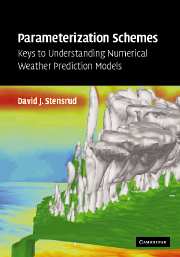Book contents
- Frontmatter
- Contents
- Preface
- List of principal symbols and abbreviations
- 1 Why study parameterization schemes?
- 2 Land surface–atmosphere parameterizations
- 3 Soil–vegetation–atmosphere parameterizations
- 4 Water–atmosphere parameterizations
- 5 Planetary boundary layer and turbulence parameterizations
- 6 Convective parameterizations
- 7 Microphysics parameterizations
- 8 Radiation parameterizations
- 9 Cloud cover and cloudy-sky radiation parameterizations
- 10 Orographic drag parameterizations
- 11 Thoughts on the future
- References
- Index
2 - Land surface–atmosphere parameterizations
Published online by Cambridge University Press: 05 September 2013
- Frontmatter
- Contents
- Preface
- List of principal symbols and abbreviations
- 1 Why study parameterization schemes?
- 2 Land surface–atmosphere parameterizations
- 3 Soil–vegetation–atmosphere parameterizations
- 4 Water–atmosphere parameterizations
- 5 Planetary boundary layer and turbulence parameterizations
- 6 Convective parameterizations
- 7 Microphysics parameterizations
- 8 Radiation parameterizations
- 9 Cloud cover and cloudy-sky radiation parameterizations
- 10 Orographic drag parameterizations
- 11 Thoughts on the future
- References
- Index
Summary
Introduction
It is always enjoyable to walk outside on a cool, clear, crisp day and feel the sun warming your clothes and skin, taking the chill away. The sun's radiation also plays a similar role for the Earth's surface. As sunlight reaches the surface, some of it is reflected back to space, but much of it is absorbed and acts to warm the Earth's surface. In addition, the atmosphere emits longwave (infrared) radiation that acts to warm the surface. The energy provided by these two radiation sources must either be stored in the ground or transferred to the atmosphere via sensible and latent heat flux and longwave radiative flux. The partitioning of this energy into the storage and sensible and latent heat components plays a large role in determining the temperature and humidity near the ground surface, making a day strolling in the park either pleasant or uncomfortable.
The variation in the sensible and latent heat fluxes from location to location is significant (Fig. 2.1). Some of the variations in total flux are due to location influencing the amount of radiation reaching the ground surface. However, much of the horizontal variation in the relative amounts of sensible and latent heat flux is due to the ground surface conditions. The soil type, vegetation type and health, and soil moisture all strongly influence how much energy is partitioned into sensible heat flux (warming) and how much energy is partitioned into latent heat flux (moistening).
- Type
- Chapter
- Information
- Parameterization SchemesKeys to Understanding Numerical Weather Prediction Models, pp. 12 - 62Publisher: Cambridge University PressPrint publication year: 2007



